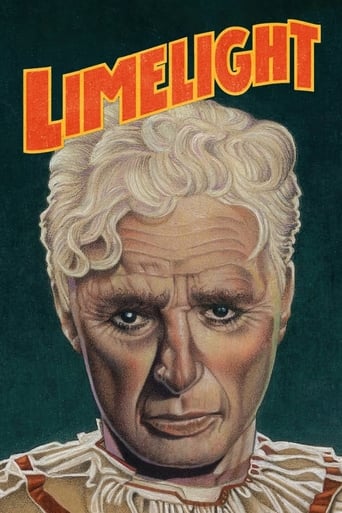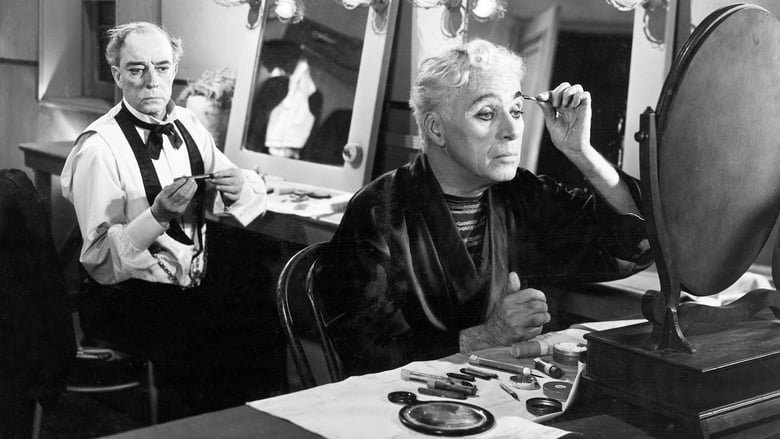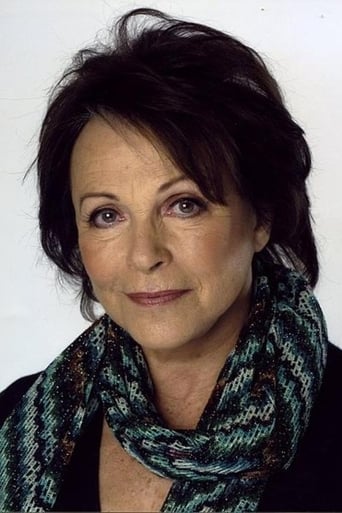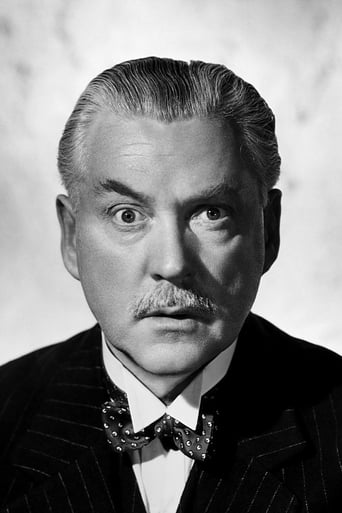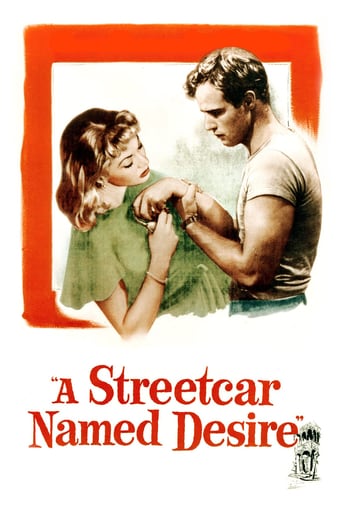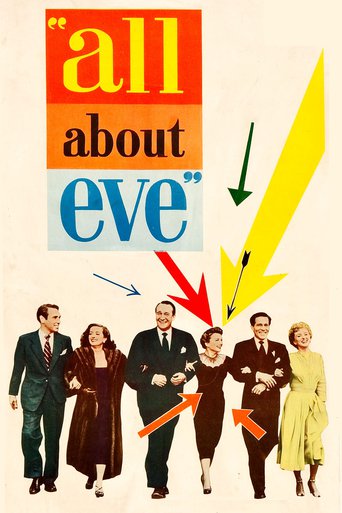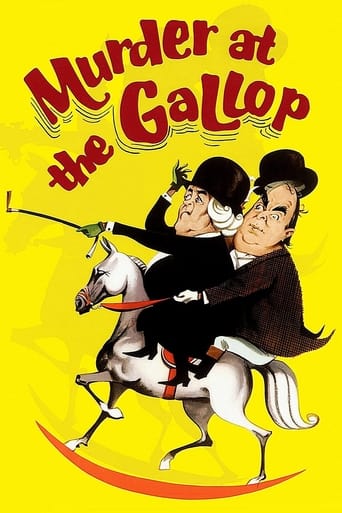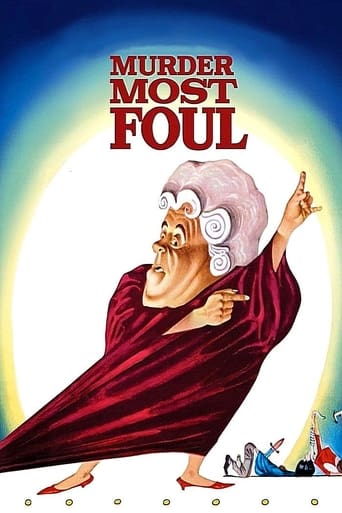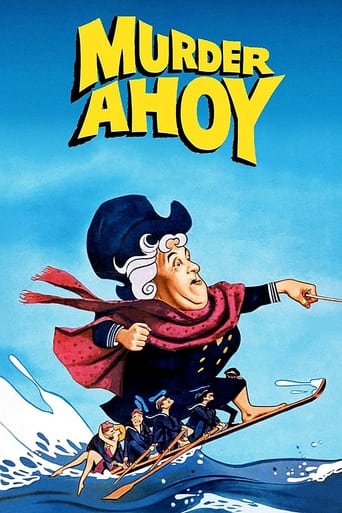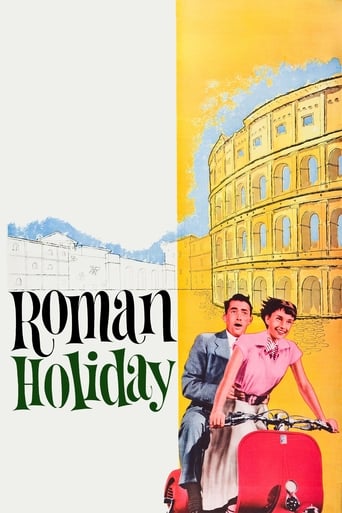Limelight (1952)
A fading music hall comedian tries to help a despondent ballet dancer learn to walk and to again feel confident about life.
Watch Trailer
Cast


Similar titles
Reviews
To me, this movie is perfection.
Pretty Good
This is a small, humorous movie in some ways, but it has a huge heart. What a nice experience.
The biggest problem with this movie is it’s a little better than you think it might be, which somehow makes it worse. As in, it takes itself a bit too seriously, which makes most of the movie feel kind of dull.
Associate director: Robert Aldrich. Art director: Eugene Lourié. Choreography: Charles Chaplin, André Eglevsky, Melissa Hayden. Music: Charles Chaplin. Music director: Keith Williams. Music orchestrations: Ray Rasch. Songs: Charles Chaplin, Ray Rasch. Celebrated — United Artists. Producer: Charles Chaplin.Copyright 23 October 1952 (in notice: 1951) by Celebrated Films Corp. Released through United Artists. New York opening simultaneously at the Astor and Trans-Lux Sixtieth Street: 23 October 1952. U.S. release: 6 February 1953. London opening at the Odeon, Leicester Square: 23 October 1952. U.K. release: 2 February 1953. Australian release: 18 June 1953. Sydney opening at the Regent. Copyright length: 102 minutes. U.S. length: 143 minutes. U.K. length: 140 minutes. 12,636 feet. Australian length: 137 minutes.SYNOPSIS: London in 1914: A once-famous but now passé, music-hall comedian befriends a young but discouraged, aspiring ballerina.NOTES: A Prestigious Hollywood Award went to Charles Chaplin, Ray Rasch and Larry Russell (a mystery nominee who doesn't figure in the above credits at all) for the Best Original Dramatic Score of 1972 (yes, 1972 for "Limelight" was not released in the Los Angeles area until that year), defeating Images, Napoleon and Samantha, The Poseidon Adventure, and Sleuth.The music includes a concerto, a ballet called "The Death of Columbine", "The Sardine Song", "The Animal Trainer", "Spring Is Here" and the top-of-the-hit-parade "Terry's Theme" which Frank Chacksfield and His Orchestra turned into the best-selling record of 1953 in England and Australia. "Limelight" was number twelve at Australian ticket-windows for 1953. Oddly, it's the Australian version (plus a 4-minute segment) rather than the British or American version that both Image and Warner Home Video have released on DVD.COMMENT: Like his immediately previous feature, "Monsieur Verdoux" (1947), "Limelight" finds Chaplin in an extremely self-indulgent mood. Even in its slightly abbreviated Australian version, I found the film far too slow, too sentimental, too heavy, and the climactic pantomime sadly unfunny. What's more the film has another big negative for me. I can't stand Claire Bloom in her self-pitying mood.I don't mind sentiment, so long as the characters are attractive. But Limelight's people did not arouse my sympathy. Maybe I'm hard- hearted. Everyone else loved the movie. I found it a dull drag. Indifferent photography and direction, added to minuscule production values, didn't help either. I suffered it through to the end, but I was mighty glad when it was all over.OTHER VIEWS: A very moving film. One of the Top Ten Pictures of 1952. — Bosley Crowther in The New York Times. -
I just caught the last scene in this movie today, and found it literally breathtaking. The comedy skit before that, with Chaplin and the pianist, is both funny and disturbing. The violinist becomes demoniacal when he finally plays.But then when he starts to die, on the couch in the prop room, the movie becomes a study in carefully-controlled understatement. I was particularly struck by the moment immediately after he dies, on the bed in the wings, when someone pulls a white sheet up over him. The camera moves in and you expect the man will stop, or at least slow down, when the sheet gets to Chaplin's neck, so the camera can focus on his face. Not at all. The sheet is pulled all the way up, and the clown's body is carried off in the wings without one sentimental second. We are left watching the ballerina dancing, to Chaplin's Oscar-winning tune, followed by her perfectly projected shadows.It's a very impressive scene.Now I have to watch what leads up to it!
Before seeing Limelight, I thought Chaplin's three masterpieces are 'The Gold Rush', 'City Lights', and 'Modern Times'. "The Great Dictator" makes me crying, in the last scene as well as 'The Kid'. Today, when I see Limelight, I was disturbed, I was ill-treated, I was very much disturbed. But after the film, I couldn't help but saying a word - The Greatest artist of all time. As a director, he is a master of misen-en-scene, in the beautiful scenes, interiors of Gold Rush, Modern Times - but Limelight, I can't think he couldn't make a film like this. As a director of Modern age, it is as tough to make a film like silent ages, and as a king of silent age, it was also very tough to make a film like Limelight. He was a king in music, and so was his theme. And one can feel what a true artist should be. Remember the very last scene, The king was dying, and then camera was slightly tracking back, then the close shot of his beloved...she was still dancing, seeing her king of heart dying...yet, as a artist her 1st preference was her art..Brilliant..not a clown..but the greatest Artist..Yes remembering all field..THE GREATEST ARTIST OF ALL TIME.
Ever since "The Kid" the British born Charles Chaplin had been a monument of American silent film making. Despite his refusal to concede to the inevitable wind of change in the business he stubbornly continued to make silents in the time of sound. But he finally had to say farewell to the little tramp - only to resurrect another version of him in the essential and daring satire "The Great Dictator". With it Chaplin arrived in the new area, safe and with sound, genius undiminished. "Limelight", made years later in 1952, however marks a crossroads for Chaplin and practically forestalls his swansong. Similar to his "Dictator" he was ahead of his time when he made the picture as it was the last film he managed to produce in the US before he became an unwanted person under the suspicion of supporting un-American intentions..."Limelight" in many ways tells Chaplin's own story about a former vaudeville star now on the path of decline, where the full weight of reality catches up with him. It's a melancholic film about the clown Calvero's struggle, but also one of hope and inspiration when he rescues a suicidal ballet dancer and helps her to regain new courage to face life despite he himself is in a downward spiral. But things are not as simply cut as they seem and triumph and tragedy are closely linked... Together with Chaplin stars an impressive Claire Bloom as the girl saved by Calvero, Nigel "Dr. Watson" Bruce as the impresario harking back to his days as Sherlock Holmes assistant, Chaplin's own son Sydney and last but not least the great former rival and by now completely broke Buster Keaton. The latter in a minor, but pivotal, crucially transcending role as assistant on the side of the great clown. All those autobiographical references are evident and become even stronger when we know that recognition for this masterpiece came only more than 20 years after the release of the film in Europe in form of an US Academy Oscar for best score, which - of course - Chaplin co-wrote. To speak with Calavero's own words: "Limelight" is a story about "the enigma of the heart and the mind"... As was Chaplin: a restlessly creative enigma with heart and mind.

